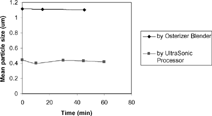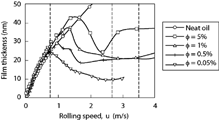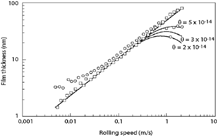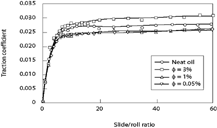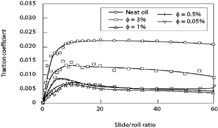Abstract
Emulsions, consisting of a small volume of oil dispersed in water in the form of small particles, are popular lubricants for metal rolling and some machine design applications. A number of mechanisms have been suggested for the lubricating behavior of emulsions, among which plate-out, starvation, and dynamic concentration are of particular interest here. At low speeds, the emulsion provides essentially the same lubricating ability as neat oil for a point contact, consistent with plate-out. At some critical speed, the emulsion behavior departs from the neat oil, associated with starvation of the inlet zone. At a second critical speed, dynamic concentration becomes the important mechanism. This article measures the film thickness and traction coefficients of oil-in-water emulsions in the different regimes of behavior and compares the results to existing theoretical understanding. The effect of droplet size is isolated as a causative element in fluid film formation.
INTRODUCTION
Oil-in-water (O/W) emulsions are well known and popular as lubricants in metal rolling and ironing, as well as in certain design applications where their nonflammability is advantageous. However, the mechanisms of emulsion lubrication are complex and still not well understood. It has been recognized for over three decades that emulsions consisting of only a very small percentage (5% or less) of oil can generate lubricant films only slightly smaller than pure oil. However, effective viscosity and mixture theories that were available at the time were not very useful for providing insight into emulsions (Schmid (Citation1)).
Plate-out theory was one of the first useful mechanisms developed to explain this behavior. In plate-out theory, it is assumed that when the oil droplets are attached to the surfaces, they tend to spread to an angle of ϕ, known as the wetting angle. Also, films that attach to rollers can be partially carried back to the contact or work zones for bearings or work rolls, respectively. These mechanisms explained the high film formation capability of oil-in-water emulsions, and significant research was conducted on the optimization of emulsions and their chemical formulation to help induce plate-out (see Lockwood, et al. (Citation2), Kurachi, et al. (Citation3), and Ratoi-Salagean, et al. (Citation4), (Citation5)). However, a number of shortcomings to plate-out theory exist, and it is clear that, at best, a number of additional mechanisms are important.
One final theoretical approach warrants discussion, namely starvation theories. Starvation itself can refer to different phenomenon. One phenomenon is the analogy to film formation mechanisms and a modeling approach for predicting film thickness in elastohydrodynamic (EHD) and metal rolling contacts (see Kimura and Okada (Citation6)-(Citation8), Barker, et al. (Citation9), Tozaki, et al. (Citation10), and Schmid and Wilson (Citation11)).
A different kind of starvation can occur when low-speed electrohydrodynamic lubrication (EHL) behavior is considered. If an emulsion plates out onto a surface, there is a critical speed at which the plated film becomes starved (Zhu, et al. (Citation12)), and a transition to dynamic concentration will occur. Chiu (Citation13) numerically analyzed EHL point contacts starved of lubricant, with particular application for successive rolling elements in rolling element bearings. He argued that the degree of starvation depends on the replenishment of the lubricant between two successive contacts. According to the observation, as a bearing passes by a point of interest, the lubricant is pushed to the side of the track, forming a depression in the film. Surface tension serves to pull lubricant back over the depression, eventually resulting in a uniform film. However, it is possible for a bearing to pass the same point of interest before the film is fully drawn in, resulting in a starved contact. Chiu's model works well for the data of Zhu et al. (Citation12) and is applied to the data presented in this article.
One issue that has not received sufficient attention is the nature of the emulsion in the contact zone of EHL and metal rolling contacts. Reich et al. (Citation14) demonstrated that oil is preferentially entrained in metal rolling inlet zones, and a number of researchers have confirmed this result. However, it is also generally accepted that some water must be entrained with the oil. This volume fraction has not been directly measured, and one goal of this article is to gain some insight into the volume fraction of water in the inlet zone based on traction measurements.
EQUIPMENT AND EMULSION PREPARATION
The equipment used to measure film thickness and traction force is the PCS Instruments Ultra Thin EHL Measurement System, located at the Alcoa Technical Center. It is a computer-controlled instrument for measuring the film thickness and traction coefficient of lubricants. The instrument can measure film thickness down to 1 nm with a precision of ±1 nm, and traction coefficient/traction force at any slide/roll ratio from pure rolling up to 200%. The contact is formed between a steel ball loaded against a rotating glass disk with a semi-reflecting chrome layer and a silica spacer layer on one side for measuring film thickness or a steel disk for measuring traction coefficient/traction force. The ball is half immersed in a lubricant reservoir, and the lubricant is drawn into the contact by the rotation of the ball. Evaporation of water from the thin film was ignored. All the experiments were carried out at room temperature (about 26°C).
The oil used to make the emulsions consisted of paraffin base oil, proprietary fatty acid, and fatty ester. Some properties of the formulated oil are listed in . The oil volume concentrations considered were 0.05%, 0.5%, 1%, 3%, 5%, and 100% (pure oil). The 5% emulsions were first produced through one of the three methods discussed below, and the more diluted emulsions were then obtained by adding certain deionized water into the 5% emulsions. Particle size distributions were examined both before and after the dilution and were found unaffected by the dilution process. The emulsions were used quickly after preparation (within two hours) with checking of the particle size distribution every half hour. It was shown that the droplet size distribution did not change in this time ().
TABLE 1 Properties of Oil
Three instruments were used to produce the emulsions: an Osterizer 10-speed blender, a colloid-blender, and an UltraSonic Processor (Model GEX 600-5). The UltraSonic Processor produces a distribution with two peaks, referred to as a “bimodal distribution,” while the Osterizer and colloid blenders produce more Gaussian distributions, or “unimodal” distributions, as shown in . Also, the UltraSonic Processor produced a much smaller mean particle size.
FIG. 2 Particle size distribution for three different methods of emulsion preparation, using an initial oil concentration of 1%.
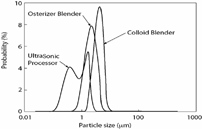
The particle sizes were measured with LS Variable Speed Fluid Module Plus (Beckman Coulter Instrument LS230) with a range from 0.04 μm to 2000 μm. As shown in , the mean diameter for emulsions mixed with the colloid blender is around 4 μm, with the Osterizer blender it is around 2 μm, and with the UltraSonic processor it is around 0.6 μm.
FILM THICKNESS BEHAVIOR IN POINT CONTACT
The technical literature concerning emulsions contains many apparently conflicting claims of lubricating mechanisms, effects of particle sizes, and presence or absence of water in the contact. The EHD experiments of Zhu et al. (Citation12) and the results presented below demonstrate that an emulsion is more complex than a single phased lubricant, and three different regimes exist where the mechanisms of emulsion lubrication can be quite different.
At very low speeds, there is little difference between the emulsion and the pure oil, and this suggests that a film of oil has plated out and provides effective lubrication. Above a certain threshold, referred to as the “first critical speed” in this article, the emulsion shows a sharp decrease in film thickness, and an increase in friction in metal rolling (Reich et al. (Citation15)). Above a second critical speed, the film thickness increases with speed again, and this is thought to indicate the presence of dynamic concentration.
Experiments were performed to identify the critical speeds as a function of oil concentration and droplet size and also to investigate traction behavior in the different regimes of behavior.
Experimental Investigation
In the present investigation, the load was set at 20 N for all experiments. shows a typical measurement of film thickness as a function of speed under a pure rolling condition and is consistent with the measurements of Zhu et al. (Citation12). For emulsions, the curves of film thickness follow the track of pure oil until a first critical speed, when a clear decrease in film thickness with increasing speed occurs. At a second critical speed, the film thickness again begins to increase with speed. It is also observed that starvation occurs at lower speeds as the concentration decreases, as shown in . It should be noted that this behavior persists for both unimodal and bimodal distributions.
is redrawn in linear coordinates to emphasis the transition regime in . Three critical speeds were chosen, as indicated by dashed lines, to investigate traction force at starvation. The first speed is 0.75 m/s, when all curves for emulsions are still increasing. The second is 2.75 m/s, when most of the emulsions show the lowest film thickness after the initial transition. The third speed selected is 3.50 m/s, when all emulsions display increasing film thickness with speed.Application of Chiu's Model
Wilson et al. (Citation16) showed that an emulsion in an elastohydrodynamic lubrication rig encounters similar starvation mechanisms as adjacent rollers in a rolling element bearing. Chiu (Citation13) modeled the latter case and gives the following equations for film thickness:
A further possibility for evaluating emulsions is suggested by the Chiu model. For the long-term goal of understanding emulsion starvation, it is necessary to have a relationship for the amount of oil that plates onto a surface. The only remaining parameter in the Chiu model is the film thickness on the disk.
TRACTION MEASUREMENTS
It has been suggested (Schmid and Wilson (Citation11)) in the past that the reason for the first transition speed was a transition from a fully flooded film developed by plate-out to a starved film consisting of neat oil due to a depression in the inlet film resulting from a mechanism described by Chiu (Citation13). The second critical speed was thought to indicate a transition from Chiu-type starvation to dynamic concentration (Schmid and Wilson (Citation11)). In dynamic concentration, it is assumed that there is some water entrained with the oil, since it becomes increasingly difficult for the water to escape near the edge of contact. Schmid (Citation1) assumed that an inversion of oil took place when the droplets are close-packed, or at a concentration of φ = 0.90, while also admitting the possibility for only oil to be entrained. In actuality, most emulsions invert at a far lower oil concentration. One of the goals of the traction measurements was to infer the presence or absence of water in the entrained film.
Note that the film thickness measurements were conducted using a steel ball on a silica spacer layer, while the traction measurements were conducted using a steel-on-steel tribopair. The traction behavior of the steel-on-steel tribopair and the lack of any noticeable wear on the ball or disk suggest that the traction experiments were conducted in a full film lubrication regime. While the chemistry of the emulsion is important for surface wetting and for provision of boundary lubricants, this is less important for hydrodynamic cases. Given the film thicknesses measured above and the consistency between traction responses of neat oil and emulsions presented in this section, it is expected that a full film lubrication condition exists and the chemical effects can be safely neglected.
It should be quickly noted that the pressure-viscosity coefficient for the lubricant was obtained using the Hamrock-Dowson (Citation17) equation for central film thickness in elastohydrodynamic contacts. The resultant pressure-viscosity coefficient of the base oil considered here is 1.19 × 10−8 Pa−1.
The film thickness measurement suggested that for this emulsion system the first two critical speeds are around 0.75 m/s and 2.75 m/s. The third critical speed varies somewhat with oil concentration, but a speed of 3.50 m/s was selected as representative of the regime when all emulsions display increasing film thickness with speed. Traction measurements were conducted at these critical speeds. It is recognized that the slide/roll ratio can affect the behavior of the emulsion, and it is possible that the emulsion may undergo a transition from one regime to another. However, we felt this would be evidenced by a marked change in the traction behavior, a situation that was not noticed.
Low Speed Results
shows the traction behavior of emulsions at a low rolling speed of 0.75 m/s and slide-to-roll ratios of 0-60%. Recall from that this speed was such that the emulsions and oil give roughly the same lubricant film thickness, and it was hypothesized that the lubrication mechanism is dominated by plate-out. These explanations are supported by the measurements in .
Post-First Critical Speed Results
shows the measured traction coefficients of emulsions at a speed between two critical speeds. For pure oil, the traction behavior is nearly independent of speed. Since the inlet region is fully flooded under these conditions, the traction force is dependent only on the shear that can develop in the oil.
FIG. 8 Traction behavior of emulsions as a function of slide-to-roll ratio for different oil concentrations between the two critical velocities (u = 2.75 m/s).
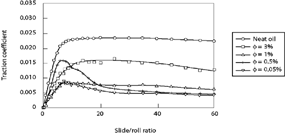
With emulsions, a clear difference in the traction behavior can be seen. The traction for the emulsion is much lower than that for the neat oil. Given the clear domination of the oil phase at slightly lower speeds, we feel that starvation consistent with the mechanisms described by Chiu (Citation13) is a better explanation, especially since the film thickness behavior is very well described by this model. The Chiu approach suggests that the oil film is starved, so that the film thickness in the inlet zone of the bearing decreases with increasing speed. As long as the EHD rig remains in the full film lubrication regime, the tractions are due to shearing of the lubricant in the contact and shearing of the lubricant in the inlet and outlet zones. The contact remains oil, but the inlet zone has less oil and more water, so the traction will decrease as the oil starves.
Post-Second Critical Speed Results
After the second critical speed, a much larger difference exists in the traction behavior of the neat oil and the emulsions. The traction coefficients observed for pure oil are fairly close to those at low speeds (there is a slight decrease in the plateau value of the traction coefficient with rolling speed), but those seen for the emulsion are much lower than those for the neat oil. Since water is so much less viscous than the oil, this behavior is explained by the presence of water. If interaction between water and oil phases is ignored, then the percentage of water in the contact zone can be determined from the rule of mixtures. This predicts approximately 20% oil phase inside the contact zone for all of the emulsions tested. This is significantly lower oil content than that considered by Schmid (Citation1) and suggested for the metal rolling experiments of Schmid and Wilson (Citation18). However, the following should be noted:
| • | Schmid (Citation1) and Schmid and Wilson (Citation18) used much more concentrated emulsions, so that the starvation of oil may have been less severe. | ||||
| • | The droplet sizes used by Schmid and Wilson were much larger than those considered here. This is significant because larger droplets seem to be captured more efficiently, as reported by Kumar et al.(Citation19). | ||||
| • | Schmid and Wilson (Citation18) considered metal rolling, whereas the results in this article are for point contact. Schmid and Wilson described the special concerns with point contact, wherein droplets that would be entrained in line contact can flow around the sides of the contact zone in point contact. | ||||
All of these suggest that a smaller concentration of oil is to be expected in the contact zone for point contacts compared to line contacts.
Note from that at a 0.05% (initial) oil concentration emulsion, the traction coefficient is higher than that seen with a 1% (initial) oil concentration emulsion. However, as can be best seen in , the 0.05% emulsion has the lowest film thickness at these high speeds, and it is suspected that an insufficient film is generated to prevent significant asperity contact. Therefore, the increased tractions are associated with increased asperity contact, not increased entrainment of oil.
Droplet Size Effects
As can be seen in , the method used to prepare the emulsions did not significantly affect the film thickness or traction results at low speeds, even though the emulsions that resulted were unimodal or bimodal, as shown in . This is consistent with the plate-out mechanism, where the contact is essentially all oil.
FIG. 10 Traction coefficient for emulsions based on three preparation techniques, for which the particle size distributions are given in . (a) Initial oil concentration of 1%, (b) initial oil concentration of 0.5%. A similar trend was found for emulsions of initial oil concentration of 3%.
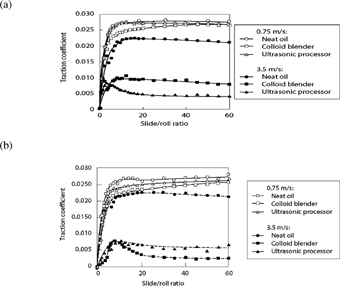
For initial oil concentrations of 0.5-3%, the results of are typical, in that at high speeds the colloid blender emulsion results in a larger traction coefficient than the emulsion from the UltraSonic Processor. Since the only difference between these oils is the particle size distribution, it is clear that the colloid blender emulsion is a more efficient lubricant than the UltraSonic Processor emulsion. The basis for this is the realization that the traction is obtained from shearing of lubricant; a larger film suggests a larger traction coefficient since the inlet is less starved of oil. Recall from that the colloid blender emulsion gives a larger mean particle size. It has long been suspected that an increase in particle size would result in increased film-forming mechanisms, and this has been demonstrated in metal rolling (Reich, et al. (Citation15)) and now for point contacts as well. Schmid and Wilson (Citation18), in their development of the dynamic concentration theory, suggested that droplet entrainment is made more efficient with larger particles and proposed that a criterion for emulsion film thickness generation could be taken as a linear function of particle size. supports this notion, since the mean particle size is roughly twice as large with the colloid blender emulsion as with the UltraSonic blender emulsion. Further experimental work is planned to confirm these results.
shows a different effect, with the UltraSonic blender emulsion yielding a higher traction coefficient than the colloid blender emulsion. Referring back to , it is clear that the film thicknesses are so small at the higher speeds that boundary lubrication is the effective regime, and the traction coefficient is arising at least partially from asperity interaction.
CONCLUSIONS
Elastohydrodynamic film thickness generating and traction behavior of O/W emulsions have been presented. Some conclusions that can be drawn from the results are:
| • | Elastohydrodynamic behavior in point contact displays two critical speeds. At low rolling speed, the emulsion behaves identically to neat oil. After a first critical value, the emulsion film thickness decreases with increasing film thickness. At a second critical rolling speed value, the emulsion film thickness begins to increase again. The first critical speed for the emulsion seems to depend on the initial oil concentration. | ||||
| • | Below the first critical speed, the traction behavior is essentially the same as that of the neat oil. | ||||
| • | Between the two critical speeds, the film thickness behavior is consistent with an inlet that is being starved of oil. The measured tractions are consistent with this behavior, with water making up roughly 80% of the emulsion in the point contact. | ||||
| • | Above the second critical speed, it was seen that the more dilute emulsions resulted in higher tractions, but this was attributed to asperity contacts, not lubricant behavior. | ||||
| • | Particle size had a noticeable influence on the film thickness and tractions developed with the emulsion, and an increase in particle size led to improved lubrication. | ||||
Acknowledgments
Presented at the STLE/ASME Tribology Conference in Ponte Vedra Beach, Florida October 27-29, 2003 Final manuscript approved September 24, 2003 Review led by Dong Zhu
REFERENCES
- Schmid , S. R. 1993 . Lubrication with Emulsion , Northwestern University . Ph.D. Diss.
- Lockwood , F. , Bridger , K. and Tudros , M. 1984 . “Interactions between Rolling Oil Emulsion and Aluminum Alloy Surfaces” . ASLE Trans. , 27 : pp 203 – 206 .
- Kurachi , T. , Yoshida , T. and Suzuki , K. 1987 . “Influence of Oil Composition and Emulsion Properties on the Rollcoating Buildup during Hot Rolling of Aluminum” . Lubr. Eng. , 43 : pp 660 – 665 .
- Ratoi-Salagean , M. , Spikes , H. and Hoogendoorn , R. 1997 . “The Design of Lubricious Oil-in-Water Emulsions” . Proc. I. Mech. E. , 211 ( pt. J ) : pp 195 – 208 .
- Ratoi-Salagean , M. , Spikes , H. and Rieffe , H. L. 1997 . “Optimizing Film Formation by Oil-in-Water Emulsions” . Trib. Trans. , 40 : pp 569578
- Kimura , Y. and Okada , K. 1985 . “Elastohydrodynamic Lubrication with Oil-in-Water Emulsions” . Proc. JSLE International Tribology Conference , : pp 937 – 942 .
- Kimura , Y. and Okada , K. 1987 . “Film Thickness at Elastohydrodynamic Conjunctions Lubricated with Oil-in-Water Emulsions” . Proc. I. Mech. E. , C176 : pp 85 – 90 .
- Kimura , Y. and Okada , K. “Film Thickness at Elastohydrodynamic Conjunctions Lubricated with Oil-in-Water Emulsions” . Trib. Trans. , 32 pp 523 – 532 .
- Barker , D. C. , Johnston , G. , Spikes , H. and Bunermann , T. 1992 . “EHD Film Formation and Starvation of Oil-in-Water Emulsions” . Trib. Trans. , 36 : pp 565 – 572 .
- Tozaki . 2002 . “Viscosity and EHL Properties of O/W Emulsions for Cold Rolling Operation” . Proc. I. Mech. E. , C68 : 1279
- Schmid , S. R. and Wilson , W. R. D. 1996 . “Lubrication Mechanisms for Oil-in-Water Emulsions” . Lubr. Eng. , : pp 168 – 175 .
- Zhu , D. , Biresaw , G. , Clark , S. J. and Kasun , T. J. 1993 . “Elastohydrodynamic Lubrication with O/W Emulsions” . J. Tribol. , 116 : pp 310320
- Chiu , Y. P. 1974 . “An Analysis and Prediction of Lubricant Film Starvation in Rolling Contact Systems” . ASLE Trans. , 17 : pp 22 – 35 .
- Reich , R. A. , Epp , J. and Festa , R. 1994 . “A Method to Study the Mechanism of Lubrication of an O/W Emulsion in Cold Rolling Aluminum Using H2 18O, SIMS and TOF-SIMS” . Lubr. Eng. , 50 : pp 31 – 35 .
- Reich , R. A. , Kasun , T. , Yang , H. and Schmid , S. R. 2003 . “The Influence of Oil Droplet Size on the Formation of a Starved Lubricant Film When Cold Rolling Aluminum Metal,”, STLE 2003 Annual Meeting . Lubrication Engineering , and submitted to
- Wilson , W. R. D. , Sakaguchi , Y. and Schmid , S. R. 1993 . “A Dynamic Concentration Model for Lubrication with Oil-in-Water Emulsions” . Wear , 161 : pp 207 – 212 .
- Hamrock , B. J. and Dowson , D. 1981 . Ball Bearing Lubrication—The Elastohydrodynamics of Elliptical Contacts , New York : John Wiley .
- Schmid , S. R. and Wilson , W. R. D. 1995 . “Lubrication of Aluminum Rolling by Oil-in-Water Emulsions” . Trib. Trans. , 38 : pp 452 – 458 .
- Kumar , A. , Schmid , S. R. and Wilson , W. R. D. 1997 . “Entrainment of Oil Droplets in Emulsion Lubrication Problems” . Wear , 206 : pp 130 – 135 .
